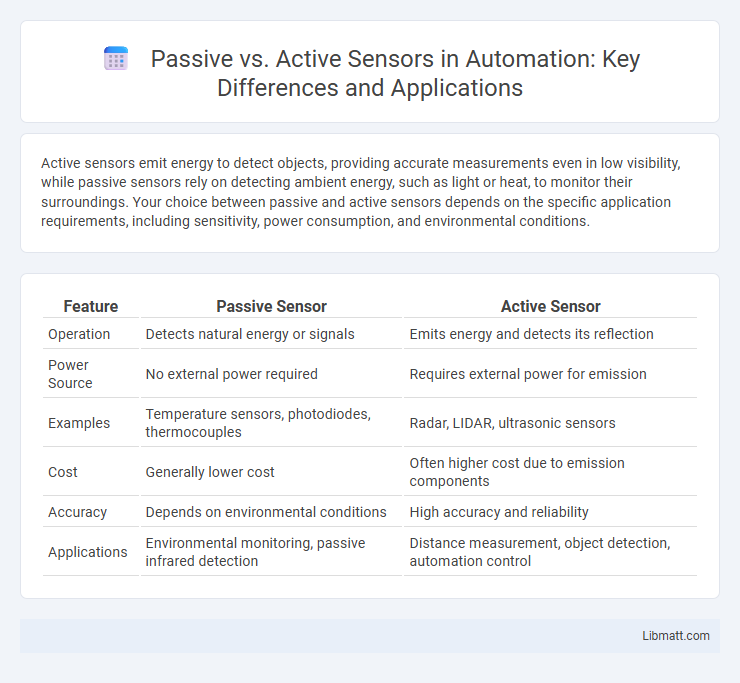Active sensors emit energy to detect objects, providing accurate measurements even in low visibility, while passive sensors rely on detecting ambient energy, such as light or heat, to monitor their surroundings. Your choice between passive and active sensors depends on the specific application requirements, including sensitivity, power consumption, and environmental conditions.
Table of Comparison
| Feature | Passive Sensor | Active Sensor |
|---|---|---|
| Operation | Detects natural energy or signals | Emits energy and detects its reflection |
| Power Source | No external power required | Requires external power for emission |
| Examples | Temperature sensors, photodiodes, thermocouples | Radar, LIDAR, ultrasonic sensors |
| Cost | Generally lower cost | Often higher cost due to emission components |
| Accuracy | Depends on environmental conditions | High accuracy and reliability |
| Applications | Environmental monitoring, passive infrared detection | Distance measurement, object detection, automation control |
Introduction to Passive and Active Sensors
Passive sensors detect natural energy emitted or reflected by objects, such as thermal radiation or ambient light, without emitting any signals themselves. Active sensors emit their own energy, like radar or laser pulses, and measure the reflection or echo to gather information. Understanding the key differences between passive and active sensors enhances your ability to choose the appropriate technology for applications like remote sensing, environmental monitoring, or security systems.
Key Definitions: Passive vs Active Sensing
Passive sensors detect natural energy emitted or reflected by objects, such as sunlight or thermal radiation, without emitting any signal themselves. Active sensors, on the other hand, emit their own energy--like radar or lidar pulses--and measure the reflected signals to gather information about the environment. Understanding these key definitions helps you select the appropriate sensing technology for applications ranging from remote sensing to environmental monitoring.
How Passive Sensors Work
Passive sensors detect energy naturally emitted or reflected by objects, such as thermal infrared radiation or visible light, without emitting any signals themselves. These sensors rely on external energy sources like the sun to capture data, making them ideal for applications like remote sensing, environmental monitoring, and astronomy. Your ability to gather accurate, energy-efficient information depends on understanding how passive sensors leverage natural radiation for non-intrusive observation.
How Active Sensors Work
Active sensors emit their own energy, typically in the form of electromagnetic waves, which then bounce off objects and return to the sensor for detection and measurement. This self-generated signal allows active sensors to operate effectively in various lighting and weather conditions, providing real-time data for applications such as radar, lidar, and ultrasonic systems. Your ability to precisely monitor environments or objects is greatly enhanced by the reliable, continuous input these sensors deliver.
Main Differences Between Passive and Active Sensors
Passive sensors detect natural energy, such as sunlight or thermal radiation, emitted or reflected by objects, whereas active sensors emit their own signal, like radar or lidar, and measure its reflection. Passive sensors generally require less power and are quieter but depend on external sources of energy, limiting their use in low-light or obstructed conditions. Your choice between passive and active sensors hinges on factors like power availability, environmental conditions, and the specific application needs.
Advantages of Passive Sensors
Passive sensors offer distinct advantages, including lower power consumption since they do not emit their own signals but rather detect natural energy like sunlight or thermal radiation. These sensors provide stealthier operation, making them ideal for surveillance and environmental monitoring because they avoid detection. Their lower cost and simpler design often result in enhanced durability and reduced maintenance requirements in various applications.
Advantages of Active Sensors
Active sensors emit their own signal, enabling precise data collection regardless of external light conditions, making them highly reliable in low visibility environments such as nighttime or fog. They provide greater control over measurement timing and frequency, which enhances data accuracy and consistency in applications like radar, LiDAR, and sonar. Your use of active sensors ensures improved detection capabilities and more comprehensive environmental monitoring compared to passive sensor systems.
Common Applications of Passive Sensors
Passive sensors are widely used in applications such as infrared thermography, environmental monitoring, and remote sensing because they detect natural energy emitted or reflected by objects without emitting signals. These sensors excel in night vision, thermal imaging, and weather observation, where detecting existing energy sources is crucial for accurate data collection. Your choice of sensor for non-intrusive monitoring or energy-efficient applications will benefit from the low power consumption and high sensitivity characteristics of passive sensors.
Common Applications of Active Sensors
Active sensors are widely used in applications such as radar systems for aviation and weather monitoring, LiDAR technology for autonomous vehicles and topographic mapping, and medical imaging devices like ultrasound scanners. These sensors emit energy to detect objects or conditions, enabling precise measurements in environments where passive sensors might struggle due to low signal levels. Industrial automation and robotics also rely on active sensors for accurate distance measurement, obstacle detection, and object recognition.
Choosing the Right Sensor for Your Needs
Choosing the right sensor depends on the application's energy constraints and environmental conditions, with passive sensors relying on external energy sources like sunlight to detect signals, making them ideal for low-power remote sensing. Active sensors emit their own energy, providing greater control over signal timing and strength, which enhances detection accuracy in low-light or adverse weather conditions. Evaluating factors such as power availability, required data resolution, and target environment helps determine whether a passive or active sensor best suits your specific monitoring needs.
Passive vs Active Sensor Infographic

 libmatt.com
libmatt.com